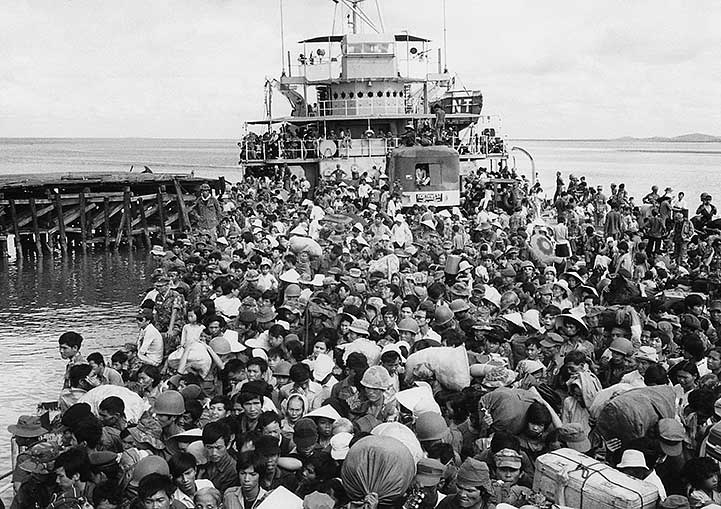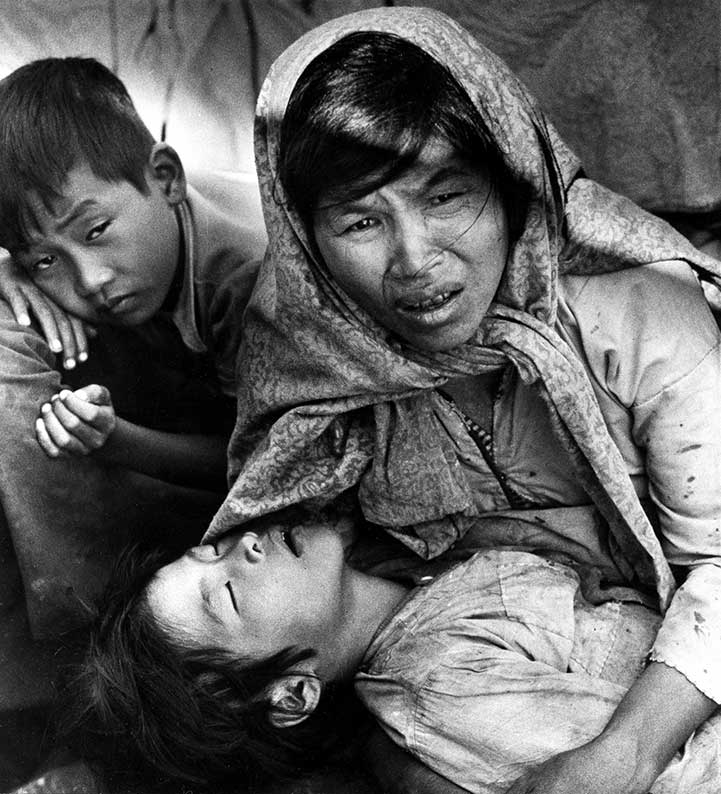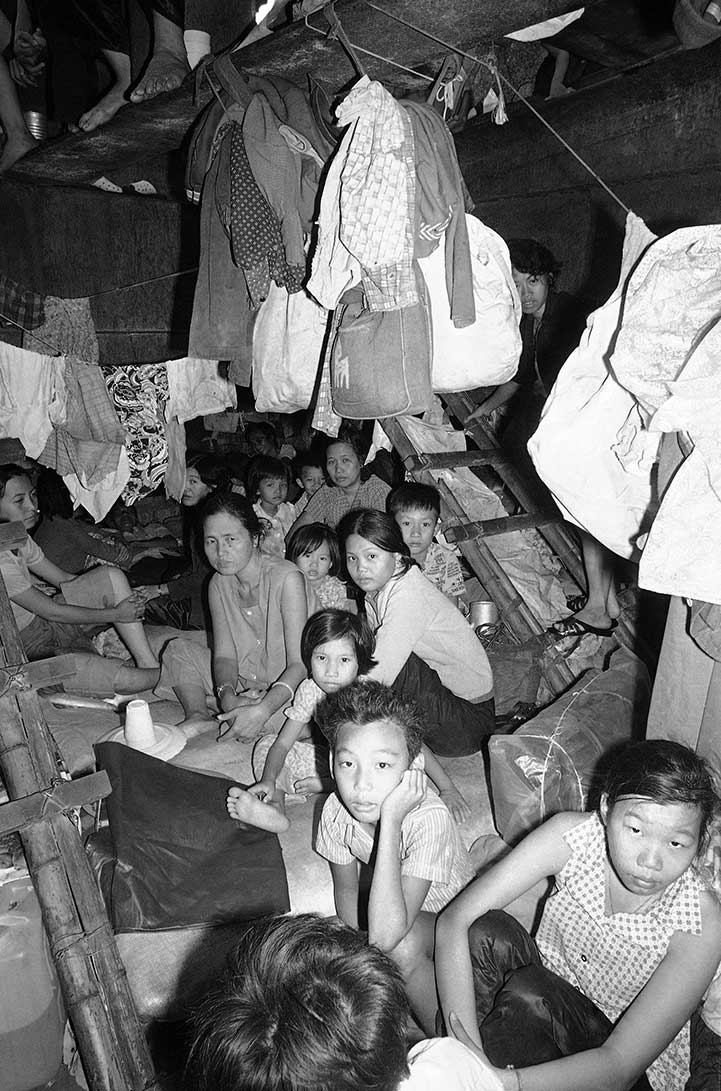
Select Language: tiếng Việt
Vietnam's refugee crisis
After the communist victory in 1975 the North simply imposed its rule on the South, demonstrating Hanoi’s lack of interest in sharing power with or consulting the masses. This was perhaps not surprising given that the North’s communist leaders had traditionally been elitists who believed in top-down control and state capitalism of the Stalinist mode.
What may have raised some eyebrows in the South, however, was that Hanoi’s leaders were just as unwilling to consult with their long-time communist-dominated allies in South Vietnam, the National Liberation Front (NLF or Viet Cong), as they were with the general population. Regular North Vietnamese Army (NVA) troops took Saigon in 1975 without the assistance of the NLF, which had been decimated during the Tet Offensive of 1968. Having seized the final victory by itself, Hanoi’s rulers felt under no obligation to make any concessions to their erstwhile allies.
Feeling it had carte blanche to do as it wished, the Hanoi leadership implemented austere communist economic policies and meted out punishments to those people it regarded as being unpatriotic or a potential threat. Many southerners were punished, with those who had worked for the US military machine in some capacity being the first to fall victim to the new rulers.
In total one million people were sent to re-education camps after 1975. For most of those punished, their stays were limited to three days of lectures and sessions, but approximately 200,000 people were detained for several years and an estimated 40,000 were held for up to 12 years.Life in the camps was hard, with many people going hungry and some dying due to illness or committing suicide. Some authors claim the new regime did not carry out widespread executions, but others, such as Mark Atwood Lawrence, claim tens of thousands were put to death.Hanoi also pursued a policy of relocating people to New Economic Zones (NEZ), partly to boost food production but also to marginalise and punish ‘troublesome’ people and to create populated buffer zones against the potential enemy of Cambodia. Religious minorities, ethnic-Chinese and the unemployed were among those selected for relocation to NEZs. The sentences to be served by inmates in NEZs were not always made clear, as was illustrated by an anecdote told by one former inmate.
“Once, I asked a cadre when I might be released. He answered: ‘When you are well re-educated in your thoughts, you will be released.’ So I asked: ‘How do I know when I’m well educated?’ He said: ‘That’s easy. When you are released, then you will know that you have been well educated.’” (former NEZ inmate in: Robinson, 1998: 29)Notwithstanding the punishments, there were various other sources of suffering for Vietnamese people in this period, especially in the South. In 1976 the communists devalued the currency of South Vietnam, wiping out its citizens’ savings. The misery was exacerbated when first China and then Russia cut their aid, including supplies of rice, triggering a rice crisis.
This was made worse when Hanoi, partly motivated by the crisis and partly by ideology, seized control of the rice trade in the Mekong Delta and collectivized farming. Industry and private property were also taken over by the authorities as Hanoi implemented its harsh brand of Communism. These moves had a disproportionately negative impact on Saigon’s ethnic Chinese community as it had dominated business operations in the South, including the rice trade.
Meanwhile, the economy as a whole was in a dire state. State capitalism was not working and people were going hungry. It would not be accurate, however, to attribute all the blame for the poor performance of Vietnam’s economy after the US war to the communist government. The war itself had caused tremendous damage to the country’s infrastructure and farmland, hampering attempts at recovery.
To make matters worse, the US, humiliated by its defeat and already refusing to deliver on its promise of paying reparations, caused more suffering by leading a global drive to isolate their stubborn former enemy. It imposed sanctions more severe even than those imposed on Cuba and persuaded the World Bank to fall in line with US policy by withholding help from the war-torn country. As a result, all humanitarian aid was stopped or blocked.
Margaret Thatcher, the Prime Minister of Britain, deemed fit to further punish the communist victors by persuading the EU to stop shipments of milk to Vietnamese children. In addition, Vietnam was spending far more money than it could afford on its occupation of Cambodia.
For many Vietnamese and Chinese-Vietnamese people, the combination of the Government’s discrimination, its austere, top-down, socialist rule, new wars against Cambodia and China and dire poverty was too much to bear. Despite the deep emotional ties many Vietnamese people have with their land, which they view as being intimately connected to their ancestors, whom they worship, more than a million people left the country by any means at their disposal from 1975 through to the early 1990s.

Refugees crowd a naval vessel docked at Vung Tau, a coastal town near Saigon on April 9, 1975. (AP Photo/Kim Ki Sam)
The first wave of refugees was to a considerable extent made up of the same people who had migrated from North to South Vietnam in 1954. Many of this first wave, which left the country in 1975 and the latter part of 1976 and 1977, were Northern Catholics with close links to the South Vietnamese Government and the American role in the war. The US was the destination for most of those from this social grouping.
By 1978, large numbers of people from Saigon’s Chinese community were also leaving the country on fishing boats, making this the second distinct group of refugees. This community, as mentioned, had been particularly hard hit by Hanoi’s anti-capitalist policies in the South.
A third distinct group which came to view their residence in Vietnam as untenable was the ethnic Chinese people of North Vietnam. Unlike the business-minded Chinese community of Saigon, the northern ethnic Chinese were mainly skilled and unskilled workers of rural stock. Their fall-out with the Vietnamese government was the result of the collapse in relations between Hanoi and China in the late 1970s rather than the Government’s communist policies.
As bad feeling intensified between the neighbouring countries, ethnic Chinese living in northern Vietnam came to be regarded with hostility by the Vietnamese government as they were suspected of favouring China. In 1978 tens of thousands of ethnic Chinese people streamed across the border into China or headed to Hong Kong on fishing boats.
This outflow accelerated dramatically in 1979 when tensions between China and Vietnam reached boiling point over Cambodia. Cambodia’s genocidal Khmer Rouge regime, which was supported by China, harboured a deep hatred of Vietnam that led it to murder ethnic Vietnamese people in Cambodia and launch killing raids on Vietnamese villages across the border.
An already war-weary Vietnam acted to defend its citizens by invading and then occupying Cambodia in 1978. In February 1979, China, enraged by Vietnam’s speedy success in removing the Khmer Rouge from power, attacked Vietnam’s northern provinces to ‘teach Hanoi a lesson.’ After occupying six provincial capital cities for a month China, believing it had sent out the necessary message, withdrew across the border.
The discovery that some ethnic Chinese-Vietnamese people had provided Chinese army scouts with militarily sensitive information during the conflict caused Hanoi’s hostility towards the country’s Chinese minority to reach fever pitch. From this point onwards, ethnic Chinese in North Vietnam were regarded with contempt and treated accordingly, with many being presented with a choice between moving to NEZs in remote areas or leaving the country.
Chen Hui Hua, an ethnic Chinese man born in Vietnam, explained how the screw was gradually tightened on Chinese people in the North.
“It began with work. Some Chinese were dismissed or transferred to bad jobs. In Haiphong, the Vietnamese used to call us friend or comrade. Now, they started to insult us. I felt very depressed. One day, some people came and dumped a load of rubble and sand right on the path in front of my house. One of them said: ‘He’s leaving. He will go and his house will be mine.’ They didn’t drive us out but they did things that made it impossible to stay.” (Robinson, 1998: 30)
Chen Hui Hua eventually took his family and walked across the border with China. Another ethnic Chinese man said: “The cadre gave us two choices. We could remain in Vietnam and be relocated to the mountains, or we could leave...We were never expelled outright. We spoke of it rather as being cleverly chased away.” (Robinson, 1998: 40)
Eventually, ordinary ethnic Vietnamese southerners also joined the exodus, mainly for economic reasons. Some had worked for the US regime in some capacity and were therefore denied employment opportunities while others were simply desperate to escape poverty, possible conscription to fight in Cambodia and/or austere communist rule.
By the middle of 1979, more than 700,000 people had left Vietnam and found permanent resettlement or temporary safe haven in other countries. This included the 130,000 Vietnamese evacuated to the US in April 1975; 235,000 who had fled north into China; 277,000 who had fled Vietnam by boat since mid-1975; and 21,000 who had fled overland into Thailand. Of these, nearly 200,000 were in camps throughout the region.
The refugees’ boat journeys, often permitted and even organised by Vietnamese officials in return for hefty payments, were notoriously dangerous. Estimates of how many people died on the high seas vary, but some sources have put the proportion at 10% to 15%. Many drowned or died from sickness, but significant numbers also died due to the callous and cruel actions of other people, especially Thai pirates.
In some instances, Thai fishermen boarded the boats and stole everything of value before carrying out repair work and helping the refugees continue with their journey. In other cases they carried out ruthless and brutal attacks on the ‘boat people.’

A Vietnamese mother, Mrs. Nguyen Thi Yen, holds her sick child as she pleads help from a fishing boat carrying her and 48 other refugees as they arrive at Khlong Yai, a village 220 miles southeast of Bankgkok, Thailand.
A man named Nhat Tien told a story about being attacked several times by Thai fishermen. After losing its engine power and drifting into the Gulf of Siam, Tien’s boat, which carried many students from the University of Saigon, was attacked and robbed by three boat-loads of Thai fishermen on separate occasions. The last of these three Thai boats towed Tien’s vessel to the deserted Thai island of Ko Kra. But it was after Tien and his fellow refugees had had a night’s sleep on the beach, their first peaceful night since leaving Vietnam, that their horror story really began.
“As dusk fell, a band of Thai fishermen bearing rifles, hammers and knives came to us with torches. They gave us a thorough search, took some clothing and then went away. Just after they were gone, another band came to take their place, searching us everywhere and this continued until midnight. All in all there were three bands that did this. The last one, completing their search, drove all the men and youths into a cave and stood guard over it while they took the women away to rape them...We could nothing but gnash our teeth and swallow our anger and shame beneath the barrels of their guns. That was the only way we could be sure no one died. It was nearly dawn when the incident ended.” (Robinson, 1998: 61)
Seventy seven per cent of all Vietnamese boats reaching Thailand 1981 had been attacked, most of them more than once, according to the UNHCR, which only began monitoring such matters in that year. A total of 571 deaths, 599 rapes and 243 abductions also reportedly took place at the hands of Thai fishermen in that year.
Malaysia’s policy of pushing back Vietnamese boats also caused a number of deaths. In one instance, a boat named the MH-3012 was intercepted by the Malaysian navy and towed for 36 hours before being cut loose and told to head for Indonesia. This, despite the fact that the Malaysian navy boat was aware that the MH-3012’s engine and water pump were not functioning.
The Vietnamese boat then drifted for four days, during which time ten people died of dehydration. Hope was restored though when a second Malaysian navy boat, the Renchong, sighted the MH-3012 and approached it. Before long however, the refugees’ hopes were replaced with anger and dread as the crew of the Renchong announced their intention to tow them south again.
A confrontation followed as the Vietnamese refused to allow themselves to be towed further away from their destination. To force the issue, Malaysian naval officers opened fire on the MH-3012, hitting one man in the arm. The violence achieved its aim, compelling the refugees to submit. Rattled and vengeful, the Malaysian officers then towed the MH-3012 at high speed in a zig zag motion, causing the Vietnamese craft to take on water and capsize.
The Renchong reportedly then circled the drowning Vietnamese people for half an hour while its crew members took photos of the unfolding disaster. By the time it began picking up survivors, there were only 124 people left alive.
While some took advantage of the refugees’ vulnerability, others tried to help. From 1975 to late 1978, ships from 31 countries rescued a total of 186 boats carrying 8,674 people. Although the number of sea rescues fell in the first half of 1979 after several countries refused to allow rescued people to be dropped off at their ports, it picked up again in the latter half of that year, when 81 boats carrying 4,031 people were rescued.
The traumatic boat journeys were followed by stays in refugees camp dotted around South East Asia as people waited to be resettled in third countries. No countries in Asia allowed Vietnamese refugees to settle in their territory, meaning all the escapees had to wait to be relocated to Western nations.

The cargo hold of the stranded Hong Kong – based refugee ship Tung An remains a hot , crowded place almost a week after the freighter steamed into Manila Bay Jan. 2, 1979. The government is supplying food and medicines, but it won’t allow the Vietnamese “boat people” to land. (AP Photo/AH)
For some, their stays in the camps, some of which were characterized by rivalries, violence and sexual abuse, were mercifully short. Others waited for years to be resettled, their mental health and functionality deteriorating all the while.
For example, those refugees who stayed in the Hong Kong refugee camps for long periods before being resettled in Britain reportedly had great difficulty in integrating into mainstream society in their new homeland. Mental health issues, drug addiction and criminal mentalities blighted the lives of many of these long-term camp inhabitants.
